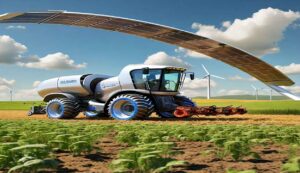Discover these 15 methods for using solar technology in agriculture
Use of solar technology in agriculture: Solar technology has the power to completely transform sustainable agriculture, as long as the sun shines. Solar energy provides a variety of uses, including equipment operation and irrigation system powering. Farmers may lower emissions and expenses by using less fossil fuel and more solar energy. Solar arrays installed on the ground or on farm roofs maximize land use while producing sustainable energy. Furthermore, accurate crop monitoring and management are made possible by solar-powered sensors and drones, which boost productivity.

Solar technology: what is it?
The importance of solar technology in advancing sustainable agriculture practices is becoming more apparent. Solar panels may provide a sustainable energy source for a variety of agricultural activities, removing the need for fossil fuels by harnessing the sun’s energy. Over time, this shift not only reduces carbon emissions but also offers a more cost-effective substitute. A grasp of the parts and functions of solar technology is fundamental.
Solar panels, also known as photovoltaic cells, convert sunlight directly into electrical power. Certain equipment, irrigation systems, and greenhouse heating systems may all be powered by this energy. For example, irrigation systems that run on solar power may raise agricultural yields while using as little as 30% less water. In addition, electric fence and farm lighting are powered by solar energy, which boosts security and productivity.
Solar technology offers affordable and ecological solutions
Because solar technology offers affordable and ecological solutions for a range of farming activities, it is completely changing the agricultural industry. Solar-powered irrigation systems, which use solar panels to power pumps that supply water directly to crops, are one of the biggest innovations. They save energy expenses and water waste. By converting sunshine into electricity and installing them on farm buildings, photovoltaic panels help farms operate with less dependence on fossil fuels.
Innovative heating systems that capture solar radiation to provide ideal growth conditions throughout the year are another way that greenhouses are profiting from solar energy. Pest control has undergone a green revolution thanks to solar-powered methods that keep pests away without using toxic chemicals. Solar water pumps provide a steady supply of fresh water, which is essential for animal health, ensuring that livestock welfare is not overlooked.
Solar systems are a dependable ally for remote farms
Off-grid solar systems are a dependable ally for remote farms that are often cut off from the grid since they provide the necessary power for everyday operations. Utilizing the sun’s heat to extract moisture from food, solar dehydrators enhance the efficiency of crop drying, an essential post-harvest procedure. Solar-powered devices are being used for surveillance and monitoring, keeping a close check on operations on farms.
Solar illumination brightens outbuildings and increases working hours on farms without increasing power costs. The integration of solar power with precision agriculture, which depends on precise data for crop management, results in a smart agricultural environment. Barns and livestock shelters benefit from solar heating as well, since it keeps animals warm throughout the winter.
Because they can provide electricity where it’s most needed, portable solar generators have become indispensable for fieldwork. Produce may be sustainably stored using solar refrigeration, which preserves freshness while using less energy. Not to be outdone, aquaculture systems also rely on solar energy to maintain healthy aquatic ecosystems and control water temperature.
15 Solar Technology Applications for Agriculture
Solar-powered Devices irrigation
Globally, there has been an increase in interest in solar-powered irrigation technology, as governments have been pushing policies to promote sustainable energy options, such as solar energy. Solar-powered irrigation has the potential to be very effective in the agricultural sector in overcoming energy shortages that interrupt the supply of electricity required for lifting and distributing irrigation water. This technique lessens farmers’ susceptibility to energy shortages that limit their ability to produce goods in a dependable, economical, and ecologically friendly manner.
The use of solar technology in agriculture is growing quickly, and a paradigm for inclusive and sustainable solar irrigation has been devised. The goal of this framework is to make solar irrigation economically and socially feasible by addressing the gaps in knowledge pertaining to energy, water, and food security. The desire to guarantee water availability in order to increase food production, reduce energy expenses and carbon emissions from fossil fuels, and increase human resilience to the effects of climate change is what spurred the development of off-grid solar photovoltaic irrigation.
A more economical alternative to conventional irrigation techniques, solar-powered irrigation systems enable more effective water conservation on farms. These systems include wireless communication technology for ease of use and are designed to be compatible with current water systems. An Android app that has been connected to a Bluetooth network may be used to control them.
Solar Panels for Agricultural Use
The ability to collect the sun twice is provided by agrivoltaics, which is described as agricultural work carried out underneath or in between rows of solar panels. This might have positive effects for farmers, rural communities, and the solar business. In order to address any concerns farmers may have about this method, the Department of Energy Solar Energy Technologies is investigating the benefits and drawbacks of agrivoltaics. The preservation of agricultural land and farm ownership for future generations, as well as the potential for extra cash via land lease payments or other financial arrangements, are benefits that farmers and landowners enjoy.
Solar Energy for Greenhouses
Passive solar design concepts maximize heat absorption and minimize heat loss in greenhouses. A sustainable and energy-efficient solar-powered greenhouse is created by using solar panels to provide electricity for the greenhouse’s electric fans, pumps, and lights, among other electric appliances. An energy-efficient greenhouse with solar panels installed may be able to run off the grid or produce as much energy for its operations as it uses.
Solar-Powered Insect Control Products
In agriculture, solar technology may also be used for pest control strategies. Solar-powered devices for pest control, such as traps, deterrents, or electronic repellents, may be used as part of solar-powered pest management systems, albeit specific search results were not offered for this subject. By encouraging ecologically friendly pest control techniques and lessening the need for chemical pesticides, these methods may support sustainable agriculture.
Solar-Powered Animal Water Pumps
Solar-powered water pumps may be generated by photovoltaic (PV) panels or solar radiation using thermal energy. They provide an environmentally friendly and more affordable option to water pumps that run on diesel or utility energy. When grid power is unavailable or unfeasible and other energy sources must provide enough energy, these pumps might be helpful. Private businesses have begun to expand the market for solar water pumps in Kenya; these systems, which ensure the availability of water for livestock and drinking, are often funded by foreign donors.
Sustainable Energy Solutions for Isolated Farms
Off-grid solar energy systems are essential for isolated farms without access to traditional power sources. By reducing dependency on grid power and diesel generators, these systems provide a stable and eco-friendly energy supply for a variety of agricultural applications. These devices provide continuous energy for essential activities, which increases the resilience and self-reliance of isolated farms.
Using Solar Dehydrators to Dry Crops
Using solar energy, solar dehydrators prolong the shelf life and preserve the quality of food. By offering a practical and environmentally responsible substitute for traditional fuel-powered drying processes, these devices reduce reliance on such practices and encourage sustainable farming practices.
Solar Powering Farm Security and Monitoring
Monitoring crop growth, spotting insect infestations, and guaranteeing the protection of agricultural assets are just a few of the uses for solar-powered surveillance and monitoring systems in agriculture. These systems increase the general security and efficiency of agricultural operations while giving farmers useful information by using solar energy to power cameras, sensors, and other monitoring equipment.
Solar Lighting for Farms
Farms and outbuildings often employ solar lighting systems to offer illumination for a variety of nighttime activities. These systems contribute to energy efficiency and lower operating costs for agricultural enterprises by providing a viable and affordable substitute for conventional grid-powered illumination.
Solar Powering the Future of Farming
Utilizing cutting-edge technology, precision agriculture aims to maximize agricultural yields and resource efficiency. By combining precision agriculture with solar electricity, solar technology may be used sustainably and effectively to increase agricultural output, lessen its negative effects on the environment, and better manage resources.
Barns and Livestock Shelters Heated by Solar Power
Animal housing facilities are heated by solar energy in solar-heated barns and livestock shelters. Particularly in the winter months, these systems provide a sustainable and eco-friendly way to keep animals in cozy and healthy living environments. Farmers may lessen their dependency on conventional heating fuels and save money and the environment by using solar energy for heating.
Fieldwork with Convertible Solar Generators
Fieldwork in agriculture benefits greatly from the use of portable solar generators. They provide a practical and sustainable power source for a range of tools and equipment. With the flexibility and portability these generators provide, farmers can get dependable electricity in distant areas without relying on conventional fuel-powered generators. As a result, they support an approach to agricultural operations that is more ecologically friendly and sustainable.
Solar Refrigeration Keeps Produce Fresh and Sustainable
Produce storage made sustainable by solar refrigeration systems, which run refrigeration units on solar energy. By eliminating reliance on conventional fuel-based refrigeration techniques and grid energy, these systems provide dependable and sustainable cold storage options for agricultural goods. Solar refrigeration reduces the environmental impact of storage operations while protecting the quality and shelf life of goods.
Solar Energy Revolutionizes Aquaculture
Aquaculture systems are increasingly using solar energy to power a variety of functions, such as temperature control, water movement, and aeration. Aquaculture operations may save money and protect the environment by using solar power to lessen their need on diesel generators and the power grid. Solar energy helps to minimize the environmental impact of aquaculture operations while promoting efficient and sustainable aquaculture techniques that promote the development and well-being of aquatic animals.
Financial Incentives for Increased Adoption
The integration of renewable energy sources and the use of solar technology in agriculture are supported by a range of funding alternatives and incentives. Grants, subsidies, and finance programs are provided by governments, international organizations, and financial institutions to assist farmers and agricultural enterprises in installing solar solutions. For agricultural stakeholders, these incentives help lower the financial obstacles to solar adoption, increasing its accessibility and viability.
Solar Water Pumps Empower Farmers
Among the most notable applications are solar water pumping devices, which provide an energy-efficient way to irrigate crops in places without access to traditional grid power. Farmers may get water from a variety of sources, including lakes, rivers, and wells, by using solar energy to power pumps. This allows farmers to maintain regular irrigation even in isolated or desert areas. This technique decreases operating expenses and environmental effects while reducing dependency on fossil fuels.
The integration of photovoltaic panels into greenhouse structures is an inventive application that facilitates the establishment of solar-powered greenhouses. By using solar energy for lighting, heating, and cooling, these buildings maximize growth conditions all year round. Solar-powered greenhouses mitigate hazards associated with climate change while promoting food security by extending the growing season and lowering energy costs.
For agricultural product preservation, solar drying technology is a viable option, especially in areas where access to conventional drying techniques is restricted. With the use of solar dryers, fruits, vegetables, and other crops may have their moisture content removed while maintaining their nutritional value and shelf life. By lowering post-harvest losses and improving smallholder farmers’ financial stability, this strategy promotes rural development and food security.
Financial viability of agricultural operations
Adoption of solar electricity in agriculture has major positive effects on the environment and economy. The financial viability of agricultural operations is strengthened by lower energy costs, increased energy independence, and possible income from excess energy output. Moreover, the environmental benefits, such as lower carbon emissions, water conservation, and ecosystem preservation, are in line with the objectives of global sustainability.
Notwithstanding these advantages, problems like high upfront expenses and complicated technology still exist. Ongoing developments in solar technology, along with encouraging laws and funding sources, are progressively removing these obstacles. Agrivoltaics and floating solar farms are two innovations that have the potential to optimize land usage and completely transform the agricultural environment.
In summary
Utilizing solar technology in agriculture offers a viable route to sustainability. Farmers may lower their carbon footprint and boost production by using solar electricity for irrigation, machinery, and monitoring systems. The environment gains from this switch to renewable energy, and agricultural techniques become more resilient, guaranteeing future generations a better and more sustainable future.

